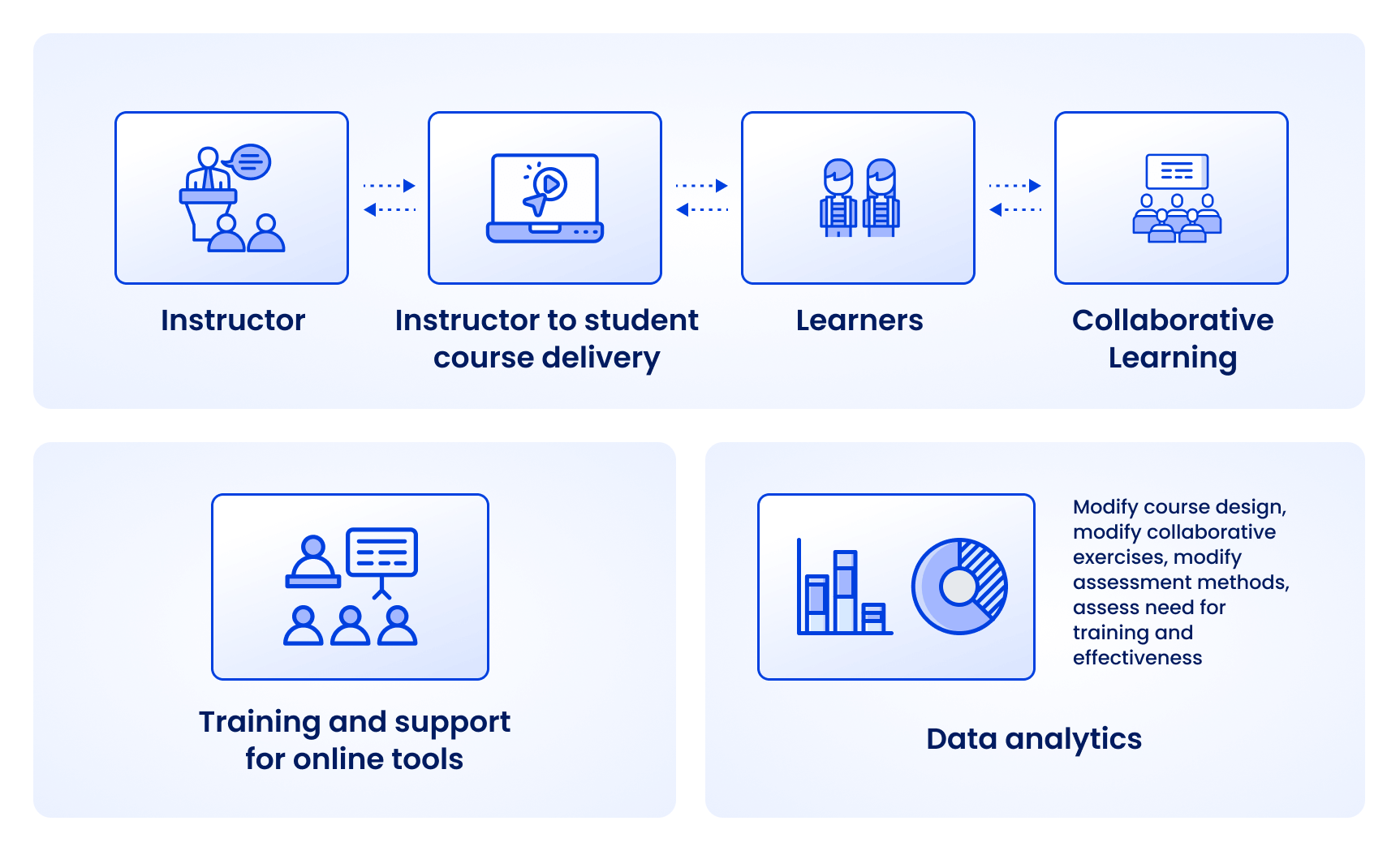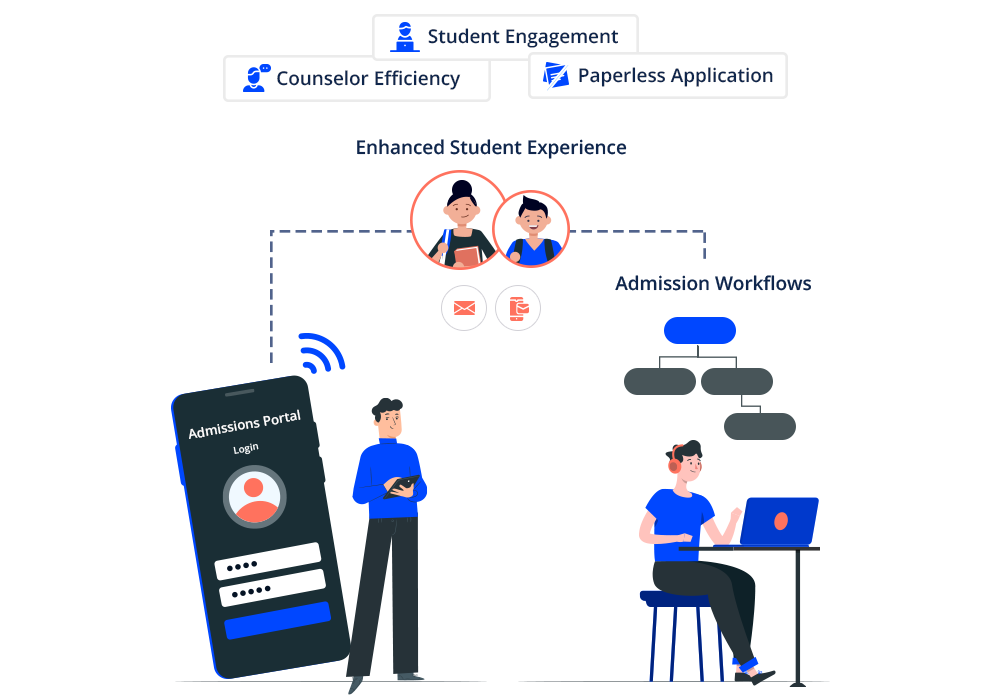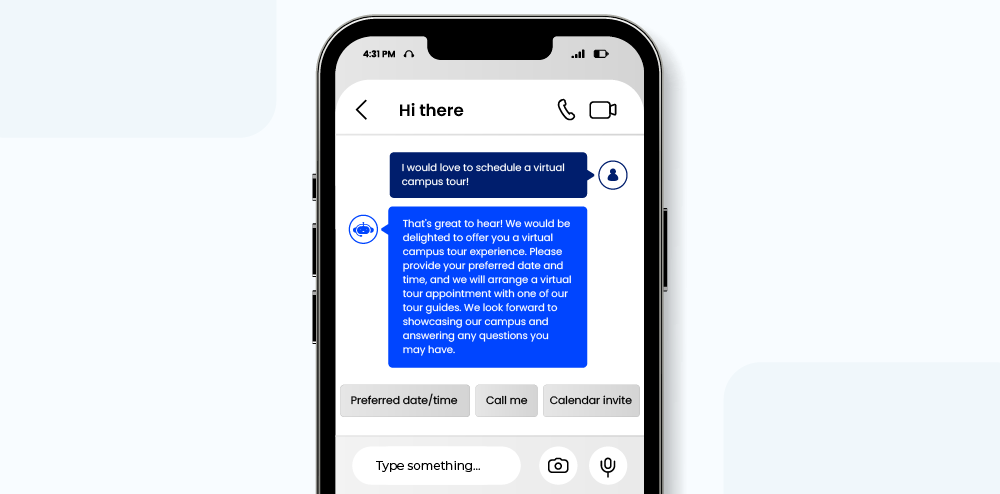-
1. What is Digital Transformation in Education?
-
2. Understanding the Key Concepts: Digital Transformation, Digitization, and Digitalization
-
3. Why is Digital Transformation Required in Education?
-
4. Key Areas of Digital Transformation in Education
-
5. Using a CRM System
-
6. Best Practices for Successful Digital Transformation
-
7. Challenges in Digital Transformation in Education
-
8. Some Insights to Consider
-
9. Digital Transformation Impact Stories
-
10. The Bottom Line: Moving Forward with Digital Transformation
With 67.5% of the global population now online, technology has become a vital part of classrooms, learning platforms, and administrative functions. From virtual classrooms and tailored learning experiences to the use of artificial intelligence and data analytics, the education sector is experiencing a surge of innovation.
As this field continues to expand, several emerging trends are set to shape the future of education, affecting both how learners interact with content and how institutions adjust to fulfill their needs. Digital transformation in education has fundamentally changed the way students learn, how institutions function and engage with current and potential students, and the overall evolution of the industry. Read on to know why and how!
What is Digital Transformation in Education?
Digital transformation in education means incorporating digital technologies into every facet of teaching, learning, and administration. It goes beyond simply using new tools; it represents a significant change in how educational institutions function and interact with students.
With the rise of online learning platforms and data-driven decision-making, digital transformation allows schools, colleges, and universities to offer more personalized, efficient, and accessible learning experiences. As technology advances, education must also adapt, prioritizing improvements in both the student experience and the operations of institutions.
Understanding the Key Concepts: Digital Transformation, Digitization, and Digitalization
These three terms—digitization, digitalization, and digital transformation—are frequently used interchangeably, yet they each have unique meanings and implications, particularly in the realms of education and business.
1. Digitization – Converting analog data to digital format
Definition:
Digitization refers to the process of transforming analog information into a digital format. This can involve scanning physical documents, digitizing textbooks, or turning paper-based exams into online versions.
Examples in education:
· Transforming handwritten student records into a digital database.
· Scanning textbooks and offering them as PDFs.
· Uploading lecture notes online rather than distributing printed copies.
Impact:
· Enhances accessibility and storage efficiency.
· Minimizes the need for physical space and paper.
· Lays the groundwork for further digital advancements.
2. Digitalization – Enhancing processes using digital technologies

Definition:
Digitalization is about leveraging digital technologies to improve and automate existing processes. It doesn’t alter the core operation of a system but enhances its efficiency.
Examples in education:
· Utilizing Learning Management Systems (LMS) like Moodle to oversee course content and track student progress.
· Automating attendance tracking through biometric systems.
· Conducting online assessments with immediate grading instead of traditional pen-and-paper exams.
Impact:
· Boosts efficiency by automating manual tasks.
· Decreases human errors and accelerates processes.
· Improves data tracking and reporting for more informed decision-making.
3. Digital Transformation – A complete cultural and strategic shift
Definition:
Digital transformation represents a strategic overhaul that incorporates digital technology into every facet of an organization, resulting in fundamental changes in how it operates and delivers value. Unlike digitization and digitalization, digital transformation redefines processes, business models, and experiences through technology.
Examples in education:
· Transitioning from traditional classrooms to hybrid learning models that combine in-person and online instruction.
· Utilizing AI-powered personalized learning platforms that cater to the unique needs of each student.
· Leveraging data analytics to forecast student performance and refine curriculum development.
· Automating student enrollment processes, communication and experience.
Impact:
· Increases accessibility and inclusivity in educational settings.
· Facilitates personalized learning tailored to individual student requirements.
· Fosters collaboration among students, teachers, and parents.
· Promotes innovation and equips students for a digital-first future.
Why is Digital Transformation Required in Education?
This transformation allows educational institutions to stay relevant, improve student outcomes, and prepare students for success in an increasingly digital society. Incorporating digital technologies into the educational framework allows institutions to streamline processes, enhance learning experiences, and foster a more engaging and interactive environment.
By embracing the digital transformation process, educational institutions can foster a digital culture that drives innovation and collaboration among stakeholders, ensuring they are equipped with the skills necessary for the future.
Digital transformation in education enhances the experience of learners and mentors and helps in institution management of student admissions and other administrative tasks. It does so by leveraging technology to simplify business processes. It provides:
- Improved access to education for people in different corners of the world, also learn from any device, anytime.
- A seamless enrollment experience for students.
- An interactive and engaging learning experience.
- Better learning outcomes.
- A seamless school/college/university administration process.
Key Areas of Digital Transformation in Education
Investment in technology has rebounded on a global scale. By 2030, analysts predict that it might turn the huge and dispersed global education sector into an $8 trillion market, with substantial funding directed towards innovative solutions in the U.S. and other key markets. This increase demonstrates a rising confidence in the sector’s ability to influence the future of education, as technology becomes an ever more essential component in improving learning experiences and broadening access to education around the world.
The following technologies are shaping and reshaping the sector:
- Artificial Intelligence (AI) & Machine Learning – Adaptive learning platforms, automated grading, and AI tutors for personalized learning experiences
- Cloud Computing – Remote learning, storage solutions, and collaborative tools that enable easy access to educational resources
- Big Data & Analytics – Personalized learning paths, performance tracking, and predictive analytics to identify at-risk students
- Virtual Reality (VR) & Augmented Reality (AR) – Immersive, interactive simulations, virtual field trips, and hands-on learning experiences in various subjects
- Learning Management Systems (LMS) – Centralized platforms for managing courses, content, assessments, and communication in digital education
- Internet of Things (IoT) – Smart classrooms with connected devices, real-time tracking of student engagement, and automated learning environments
- Blockchain – Secure digital credentials, certificates, and student records, as well as decentralized learning platforms
- Gamification – Interactive and engaging learning through game-based elements like rewards, points, and challenges to motivate students
- 5G Connectivity – High-speed internet enabling seamless access to online education, virtual classrooms, and real-time communication
- Chatbots & Virtual Assistants – AI-powered assistants that help students with queries, administrative tasks, and personalized learning recommendations
- Edutainment Platforms – Blending education with entertainment to engage younger learners, offering interactive videos, quizzes, and games
Now, let’s dive deeper into how technologies like an advanced admissions CRM system help institutions deliver better education, whether through innovative learning methods or enhancing student experience
Using a CRM System
1. An end-to-end system for enrollment processes

The admission or enrollment process is very time-consuming. Earlier, students used to stand in queues to submit their documents and admission forms. They had to visit the institution frequently to check the status of their application. On the administration front, the admission team had to vet documents, check eligibility, shortlist students, and update them with their application status.
While the system worked, the new-age admission process had to be online to make things simple for everyone – parents, students, teachers, and administration. An end-to-end admission management system helps students and institutions in the following ways:
1. Institutions can avoid the hassle of paperwork associated with the admission process.
2. Technology can help shortlist eligible candidates automatically.
3. An automated response system can offload counselors off routine inquiries.
4. Institutions can get real-time updates on the courses, faculties, students, etc.
5. Students need not stand in queues and waste time checking the status of their applications.
6. Students can simultaneously apply to multiple institutions without visiting the campus.
What’s more, career schools and technical institutes can use products like FloStack by LeadSquared to engage with prospective students immediately.
FloStack is a student engagement and scheduling solution for educational institutions. It simplifies your enrollment process by connecting with prospective students instantly, automating lead scoring and scheduling meetings, and giving personalized experiences through custom microsites.
2. Technology to manage administrative processes
Technology has made it easier for institutions to manage their daily administrative processes. It can be used to manage class schedules, raise administrative requests, and store documents. Utilizing technology to manage administrative tasks improves counselor productivity, reduces chances of human error, and builds resilient processes that don’t break down with scale.
Moving certain administrative processes online has benefitted institutions in multiple ways:
1. Cloud security has improved the way documents are stored and managed.
2. Timely reminders and optimized schedules have improved productivity.
3. Service level agreements (SLAs) and process documentation have led to faster query resolution.
Technology has helped administrators, teachers, and counselors focus more on their core job functions and not spend much time on manual and repetitive tasks.
3. Education chatbots to revolutionize communications

Using chatbots for education has evolved institutional communication between students and staff alike. AI powered Chatbots enhance support services to better cater to the varied needs of students, improving accessibility, engagement and effectiveness.
Here’s how chatbots have become emerging allies in education:
- For admissions: Using chatbots to collect basic information, share and collect documents, as well as answer FAQs have proved to be a time-saving hack for administrators and faculty involved.
- For evaluation: By sharing test links, results, conducting quizzes, chatbots help with how students grasp a particular topic. They save time spent on creating repetitive quizzes and share insights on improving teaching or learning methods.
- For query resolution: Whether the query is topic-related or regarding important submission dates, education chatbots have helped institutions save costs on hiring a resource or expecting teachers to spend more time on solving these.
- For interactive learning: Chatbots have made learning easier. From finding relevant study resources or help in writing a paper, chatbots have become a helpful tool for students to be updated in their classes.
Change is inevitable but it is also difficult to implement. Let us look at some of the challenges institutions face while transforming digitally.
4. Transforming the edtech models
With the increasing demand for online education, education technology (Ed Tech) companies have rapidly adjusted to improve student onboarding and coaching. The size of the global EdTech market is likely to reach USD 252.45 billion in 2025, and is projected to grow at a compound annual growth rate (CAGR) of 17.34% to reach USD 773.06 billion by 2033. We continue to witness the growth in EdTechs as they adopt hybrid learning and self-paced course modules.
To make these processes more efficient, many of these companies have started using edtech specific CRM solutions.
Here’s how online educators are using CRM:
· Student Inquiry Capturing and Distribution: Student inquiries come in from several channels- social media, website landing pages, offline campaigns, referrals, and more. Capturing the student inquiries and reaching out to them as soon as they arrive helps convert them faster. EdTech CRM helps route student inquiries to designated sales agents based on various attributes such as language spoken, location, subject, experience, etc. Moreover, institutions are using FloStack to engage with prospective students instantly.
· Student Intent Tracking: Knowing the students better helps the enrollment representatives pitch relevant courses. EdTech CRM captures many data points such as website visited, links clicked, time spent on each website, link, video, and more. It provides enough information to the representatives to strike up an engaging conversation with students/parents.
· Lead Scoring and Prioritization: EdTech CRM helps assign scores based on critical actions such as email opened, link clicked, website visited, webinar attended, and more. A lead with a higher score has a higher chance of a conversion, and your representatives can follow-up with such inquiries first to enroll them into courses.
· Data-driven Analytics: Having an overview of metrics such as daily calls made, leads from various sources, campaigns, email open and click rates, lead conversion ratio, and more helps make data-driven decisions. EdTech CRM such as LeadSquared provides over a hundred reports that make lead, enrollment, learner, and faculty tracking easy.
Best Practices for Successful Digital Transformation
Here are some best practices for ensuring a successful digital transformation in education:
Develop a clear digital strategy
A well-defined digital strategy is crucial for guiding the transformation process. Educational institutions should set clear goals, such as improving student engagement, enhancing administrative processes, or providing personalized learning experiences. This strategy should align with the institution’s overall mission and vision, and include specific, measurable objectives, timelines, and key performance indicators (KPIs) to track progress.
Invest in training and professional development
For digital transformation to be effective, educators and administrators must be equipped with the necessary skills and knowledge. Ongoing training programs should be implemented to ensure staff are proficient with new technologies, platforms, and teaching methods. This helps build confidence in using digital tools and creates a culture of continuous learning within the institution.
Prioritize user-centric technology
The adoption of new technologies should be focused on improving the experience of both students and educators. Institutions should carefully select tools and platforms that are intuitive, easy to navigate, and accessible for diverse learning needs. Gathering feedback from users—whether teachers, students, or staff—is essential to ensure that the technology is meeting their needs and expectations.
Foster collaboration across departments
Successful digital transformation requires collaboration across various departments, including IT, administration, faculty, and student services. By breaking down silos, institutions can ensure that the technology is integrated seamlessly into all areas of the institution. Cross-departmental collaboration also ensures that digital tools and processes are designed with the needs of all stakeholders in mind, leading to more holistic solutions.
Ensure data security and privacy
As educational institutions adopt digital technologies, they must also prioritize the protection of sensitive student data. Institutions should implement strong cybersecurity measures and comply with relevant data privacy regulations (e.g., GDPR or FERPA). Building trust through secure and transparent data management practices is essential to maintaining the integrity of the digital transformation process.
These best practices are key to ensuring that digital transformation is not just a technological shift, but a holistic improvement that enhances the learning environment, increases operational efficiency, and meets the evolving needs of students and educators.
Challenges in Digital Transformation in Education
Despite adopting various technologies, most institutions still prefer to depend on traditional teaching methods. In addition to opposing forces, there are a few other challenges in transforming education:
Lack of a clear strategy & willingness to change
Justifying investments in technology is proving difficult when there is no clear strategy for building automated systems. This sector is still driven by personnel. The lack of user-friendly systems leads to higher training costs. Administrators need third-party assistance to make changes in the processes, which causes more delays.
It is important to have a strategy to introduce technology in various aspects of education—admissions, in classrooms, teacher training, etc. It should be planned in phases and have a tracking mechanism to drive better impact.
Insufficient tech knowledge
Teachers and administrative staff focus more on helping students. They aren’t used to complex technologies with a higher learning curve. It causes more hindrance than help. Intuitive tools like LeadSquared with a centralized platform to set up automation and view student information, have much higher adoption rates.
Institutions need to conduct regular training programs for the staff to stay updated and know their way around a system. Here’s where partnerships with technology tools will drive higher adoption rates.
Dealing with system breakdowns
Institutions are heavily scrutinized for compliance and data security. Technical glitches, system errors, and data leaks can prove harmful. When combined with insufficient technical knowledge, this leads to higher errors and external dependencies.
It is better to invest in stable, secure, and scalable technology so that breakdowns can be identified and nullified in a timely manner.
Some Insights to Consider
LeadSquared held a webinar focused on digital transformation strategies for attracting and engaging qualified student leads, as well as effectively managing student relationships. It aimed to provide actionable insights on how to improve the entire student journey, from initial contact through to ongoing engagement. The discussion centered around the importance of using advanced tools and methods to connect with the right students, ensuring that the right leads are identified early and nurtured through personalized communication.
Additionally, the session explored ways to enhance the overall student experience, highlighting the role of technology in streamlining processes and maintaining strong connections with students throughout their academic journey. Attendees were introduced to various technological solutions that could help optimize lead generation, engagement, and relationship management, all while improving student success.
Now, let’s see how some leading educational institutes adopted technology to improve student experiences.
Digital Transformation Impact Stories
Seeing the lead-to-inquiry conversion ratio increase
California Career Institute (CCI) is a vocational career school that prioritizes students, dedicated to providing top-notch education in healthcare and nursing.
Earlier, the institute faced challenges like:
- Low Lead to Inquiry Conversion Rates
- Unorganized Database
- Lack of Reporting and Metric Tracking
- No Streamlined Communication Tool
With the help of LeadSquared, they were able to achieve:
- Complete Visibility into the Pipeline
- Actionable Insights Delivered on Demand
- Automation for Tighter Communications
- Student Portals for Secure Storage
And much more!
“With LeadSquared, we can take a deeper look at our processes and utilize new technology to study how we’re doing as an institution… LeadSquared has helped us bring information to students much faster.”
– Maggie Zaman, Director of Admissions, California Career Institute
Recognizing the importance of having the right technology and processes
The career-focused Southeastern College offers diploma, certificate, associate, and bachelor’s degree programs in allied health and education at five campuses in the US. After over three decades of being in existence, it needed to integrate technology into its traditional marketing and enrollment processes due to the following challenges it was facing:
- Inefficient and disjointed systems being used
- Lack of a centralized customer relationship management (CRM) system
- Low contact rates due to the absence of automated processes
- The need for a robust CRM with growing institution complexity
Here’s what LeadSquared helped them with:
- Visibility into the end-to-end admissions process
- Creation of workflows and automation of repetitive tasks
- Standardizing the enrollment process
- Integrating seamlessly with multiple applications and systems
“Our admissions coordinators have all their tasks right in front of them and are able to work smarter and more efficiently. With several different systems housing our prospective student data, sending a text message or email blast used to take 6-8 hours of work: running an inquiry report, exporting it to Excel, filtering, checking contact information, and sending the message. Now it takes 6-8 minutes.”
– Dana B. Hutton, Chief Marketing & Enrollment Management Officer, Southeastern College
The Bottom Line: Moving Forward with Digital Transformation
The future of digital transformation in education holds immense potential, with emerging technologies set to reshape how learning is delivered and experienced.
The traditional learning system has had a challenging journey. Training institutes, schools, and colleges have been forced to implement digital learning modules. Digitization in education has greatly helped learners and teachers.
However, the challenges remain in online learning and teaching. For instance, educators have not been able to measure the learning outcomes from online education accurately. Moreover, learners who do not have access to the internet, or lack smartphones/laptops, are still deprived of education.
Thus, a hybrid mix of digital and traditional learning is a way forward until digital education becomes accessible to all.
As digital transformation evolves, educational institutions will need to remain agile, adapting to new technologies and constantly innovating to provide the best learning experiences for students while meeting the demands of the modern workforce.
LeadSquared helps educational institutions, training centers, and Ed-techs transform their admission process. With a strong clientele, including top online and offline education providers and career schools, it can assist you in your digital transformation journey. Want to know how? Book a free demo today.
FAQs
1. What are the three main areas of digital transformation in education?
The three major areas of digital transformation in education include using technology to improve admission rates, adopting new methods of teaching & learning methods, and simplifying administrative tasks through technology.
2. How does digital transformation impact education?
Digital transformation in education provides –
1. Improved access to education for people in different corners of the world, by letting students fill in forms and also learn from any device, anytime.
2. A seamless enrollment experience for students.
3. An interactive and engaging learning experience.
4. Better learning outcomes.
5. A seamless school/college/university administration process.
3. What are the challenges education institutes face in their digital transformation journey?
Most institutions often return to traditional teaching methods. The reason? They didn’t have a clear digitization strategy, lacked tech knowledge among staff, and faced system breakdowns and data leaks. To overcome these challenges, institutions need technology like LeadSquared, which is stable, easy-to-use, and compliant to ensure higher returns and adoption rates.









